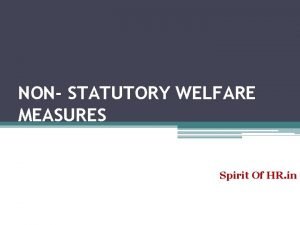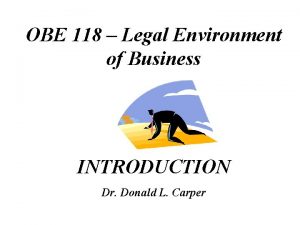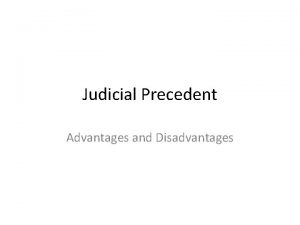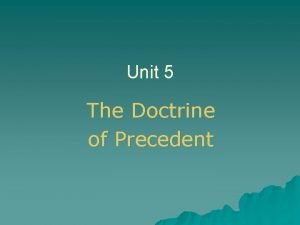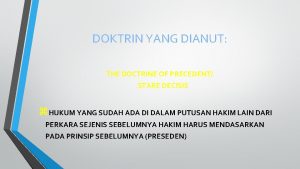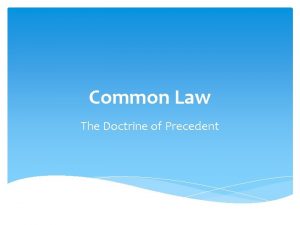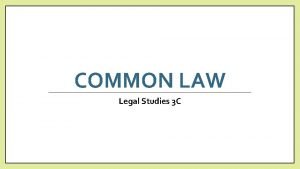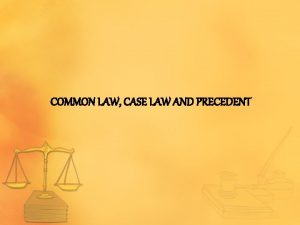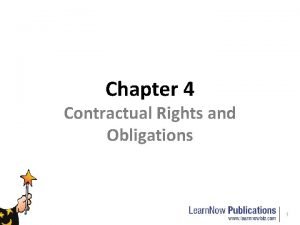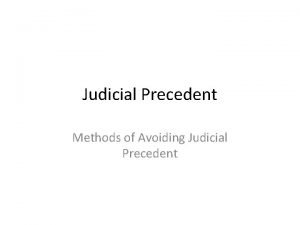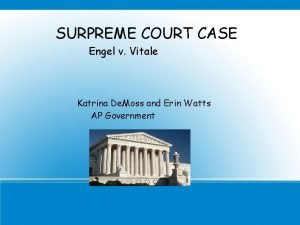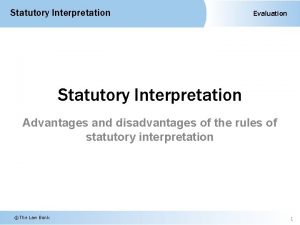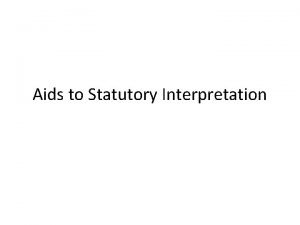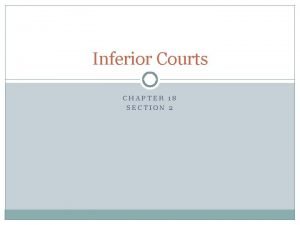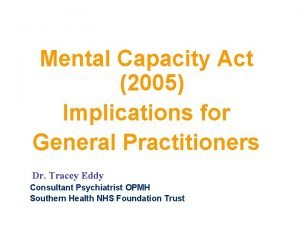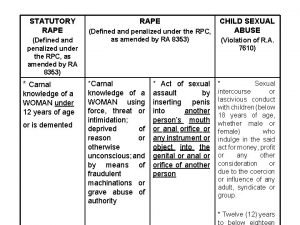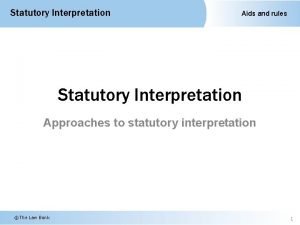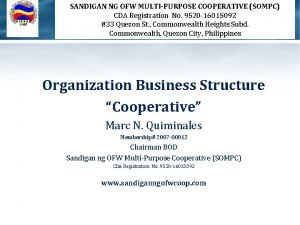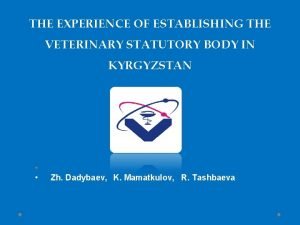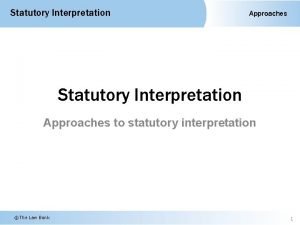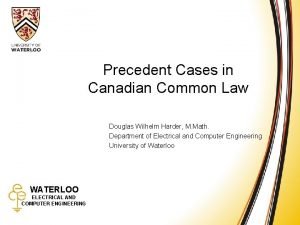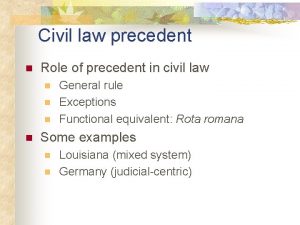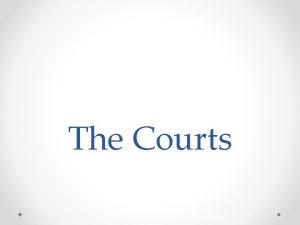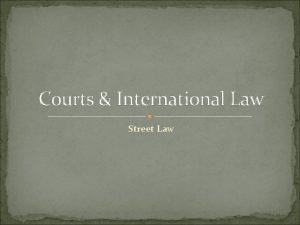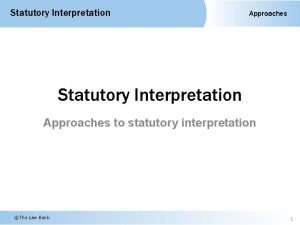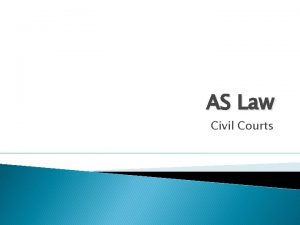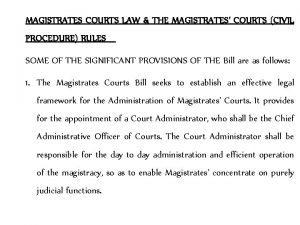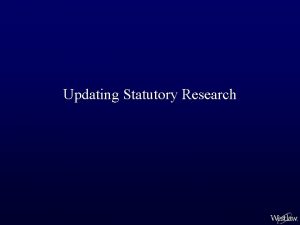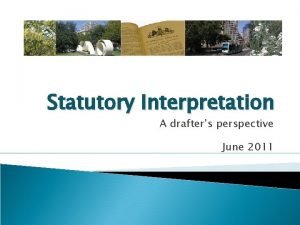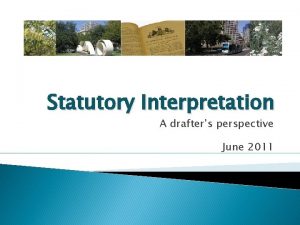Law making through the courts Precedent and statutory






























![DEING V. TAROLA [1993] 2 VR 163 (THE STUDDED BELT CASE: FACTS �A young DEING V. TAROLA [1993] 2 VR 163 (THE STUDDED BELT CASE: FACTS �A young](https://slidetodoc.com/presentation_image/6ba67b524e19eadbea461f5eef053511/image-31.jpg)






- Slides: 37

Law making through the courts – Precedent and statutory interpretation

To carry out role, courts: �The main role of our courts is to settle legal disputes. To carry out this role, courts: � 1. ) decide the facts of the case (that is, what happened) � 2. ) decide what law applies � 3. ) apply the relevant law to the facts � 4. ) reach a decision.

Precedent � Sometimes, however, the court is faced with a new situation where there is no relevant legislation and the status of the law is uncertain and unclear. � But the court still has to settle the dispute. It does this by working out a new legal rule in order to make a decision. � The court's decision becomes a precedent (statement of law) that is used to settle later cases where the material facts are similar. It is through this process of creating new precedents that it is said that courts make law.

The doctrine of precedent �As a former British colony, Australia has adopted the common law approach within its court system. �The common law also applies in countries such as the United States of America, Canada, New Zealand, India, Malaysia and a number of African countries that are former British colonies �The central feature of common law is the doctrine of precedent. �In essence this means that when deciding the outcome of a case, judges will look to the results of similar cases and will tend to be guided by the decision in those cases

The doctrine of precedent �This is the process by which judges “stand by” (stare decisis) the reasons for decisions given by courts higher in the same court hierarchy when deciding on similar future cases

Definition to add to your booklet � Common Law: � Common law is a system of law based on judge- made law or case law, as opposed to legislation or statute law � Stare decisis means to stand by what has been decided and is the basis of the doctrine of precedent � Lower courts follow, or ‘stand by’, the decisions of the higher courts in the same court hierarchy in “like cases”

Binding precedents �The operation of precedent depends on the existence of a court hierarchy. A binding precedent is one that must be followed by all lower courts within the same court hierarchy. It is a case of follow the leader. �If the High Court creates a new precedent, all courts in Australia are bound by that decision because they are lower in the same hierarchy. If the Victorian Court of Appeal creates a new precedent, then all other Victorian courts must follow that precedent.

Persuasive precedents �A decision made outside the court hierarchy currently hearing the case is not binding on the court. These decisions are referred to as persuasive precedents because they can only influence, not bind, the court. For example, the Supreme Court of Victoria may be influenced by a decision of the New South Wales Supreme Court, but is not obliged to follow the decision of the New South Wales court because it is not part of Victoria's court hierarchy.

Terms to define: �A binding precedent is a precedent created by a higher court that must be followed by all lower courts in the same court hierarchy where the facts of the cse are similar �A persuasive precedent is a decision that is not binding, but can influence a decision or be used as a guide, for example a decision made in a different court hierarchy

Ratio decidendi and Obiter dicta �The most important part of a court decision is the ratio decidendi, a Latin term meaning reason for the decision. It is binding on courts in later cases where the material facts are similar. �Many statements are made by judges during the course of a judgement that are not actually part of the final reason for their decision. �For instance, they may talk hypothetically about what they would do if the facts were different. These statements are referred to as obiter dicta (sayings by the way) and are not binding on later cases. However, they may be persuasive for later cases if they are concerned with the same hypothetical situation referred to by the judge.


Terms to define �Ratio decidendi: �the legal reasoning, or rule, upon which a decision is based �Obiter dictum �A judge’s statement of opinion or observation made during a judgment but not part of the reason for a decision

Changing precedents �When a superior court is faced with deciding a case where the same court had previously created a precedent, there is a general rule that the previous decisions of the court are not binding. �The High Court has never regarded itself as bound by its own earlier decisions. In this way, it can depart from an earlier decision if it decides that the legal principle created in the first case was incorrect. This is known as disapproving an existing precedent.


Courts may also change precedents by: � Reversing. When the Supreme Court creates a precedent, one of the parties may appeal the outcome to the High Court. If the High Court believes the lower court made an error, it can reverse the decision. This will create a new precedent. � Overruling. If a lower court creates a precedent and then a similar case is brought before a higher court, the higher court may determine the lower court erred and overrule the original precedent. The decision in the original case stands, however, the precedent no longer applies and a new precedent has been created. � Distinguishing. A court may attempt to not follow an existing precedent by distinguishing between the material facts of the two cases. The decision, in such a case, will create a new precedent.

Case study IS HUMAN TISSUE PROPERTY? JOCELYN EDWARDS; RE THE ESTATE OF THE LATE MARK EDWARDS [2011] � n 2011, Ms Jocelyn Edwards was given permission by the New South Wales Supreme Court to access her dead husband's sperm in order to conceive a child through IVF. � The court had to consider the question of whether the woman had a right to access sperm recovered from her dead husband even though the relevant New South Wales legislation, the Assisted Reproductive Technology Act 2007 (ART) states that gametes cannot be used without the written consent of the donor. Tragically, Mark Edwards was fatally injured in a workplace accident the day before he was due to sign the consent form to authorise the commencement of IVF treatment. � After considering the objectives of the legislation and an extensive number of previous court cases, the judge ruled that human tissue (sperm) could be regarded as ‘property’ and that the woman was entitled to possession. However, the judge said that under the ART Act, the sperm could not be used in New South Wales for assisted reproductive treatment, but that this did not prevent Ms Edwards from seeking treatment in another state or overseas. The interpretation of the legislation in this case becomes a precedent to be followed in later similar cases by courts in the state of New South Wales.

Statutory Interpretation �Statutory interpretation involves judges interpreting what words and phrases within a statute mean, and even determining what parliament intended when it passed the particular statute. �This is the second way in which courts make law

Statutory Interpretation �Words change their meaning over time. Words that were used in one context at one time may now be used in another context. Provide definitions of the following words: �silly �nice �tell �awful �prove.

� Compare their definitions with the actual definition and the original: � silly now means foolish. Original meaning was blessed or happy. � nice now means pleasant or socially acceptable. Original meaning was not to know, so a nice person was someone not to know. � tell now means to make known or inform. Original meaning was to count, such as a bank teller. � awful now means something that is bad or terrible. Original meaning was something wonderful or full of awe. � prove now means to show to be true or establish beyond doubt. Original meaning was to test

Key concept �Precedent operates when judges make decisions on the facts of a case and, in so doing, establish a new legal principle. �Judges can also make decisions on the meaning of words and phrases in legislation and delegated legislation. This is referred to as statutory interpretation and when a judge interprets a statute, he or she is making law.

To add to your definitions �Statutory interpretation: Is the process whereby the courts are asked to interpret the meaning of words or phrases in a statute made by parliament to resolve a dispute before the court

Case: Kevin and Jennifer �Kevin was born female, but having lived as a man – went through gender reassignment surgery, he considered himself male �Kevin and Jennifer married and applied to the Family Court to have their marriage validated �The Marriage Act (1961 Cwlth) required that a marriage between a man and a woman �Attorney General argued that Kevin was born female, and that a marriage between two females was not valid

What was interpreted? �“Man” in the Marriage act and Family Law Act

Court’s decision �Full court of Family Court found that word “man” in the statute should be determined at date of marriage not at birth and found Kevin to be male. Marriage was valid �Significance �word “man” expanded and given its current meaning, including those having undergone gender reassignment surgery. �Takes into account changes in technology and society. This set a binding precedent for further applications of this legislation

Effect of decision/ significance �word “man” expanded and given its current meaning, including those having undergone gender reassignment surgery. �Takes into account changes in technology and society. This set a binding precedent for further applications of this legislation

Reasons for statutory interpretation

Reasons. Description why legislation may Reason Description Reasonwhy legislation to legislationneeds interpreted be interpreted to be interpreted Intention ofofthe Intention theact is actnot is clear not clear need to be Parliament’s intention may notnot be clear enough. Accurate Parliament’s intention may be clear enough. instructions and direction may not havemay beennot given to the Accurate instructions and direction have parliamentary In these situations, a court may been given to counsel. the parliamentary counsel. In these undertake assist it in determining situations, research a courtto may undertake researchthe to assist intention of a law. it in determining the intention of a law. Meaningofofwords may be ambiguous Many language have multiple meanings, Manywordsinin. English language have multiple courts may have to interpret common words to may be ambiguous and meanings, and courts may have to interpret justify meaning. For example “text”. Words may also common words to justify meaning. For example change over time, for example the word “man” which was “text”. Words may alsoand change over time, for interpreted in the Kevin Jenifer case. Difficulty foreseeing Difficulty possible future foreseeing applicationspossible of the future applications law of the law example the word “man” which was interpreted in the Kevin and Jenifer case. It is difficult to foresee all future applications of a an ACT. It is difficult to foresee all future Parliament makes law in futuro andapplications it is almost of a an ACT. Parliament makes lawinintechnology futuro and it is impossible to predict changes and science, almost to predict changes. Eg inin technology or socialimpossible and environmental conditions. the Kevin and science, or social and environmental conditions. and Jenifer case. Eg in the Kevin and Jenifer case.

To add to your definitions: �Intrinsic sources are those that are contained within the legislation itself, such as words of the act, the long title, preamble and headings �Extrinsic sources are those found outside the act – for example hansard, parliamentary debates, committee reports, dictionaries and the interpretation Acts

Effect of statutory interpretation

� Creation of precedent: The decision creates a new precedent that becomes binding on lower courts in the same hierarchy when interpreting the same legislative provisions � Words are brought to life: The interpretation of a word or phrase in a statute can either broaden or narrow the term. It does not change the actual Act, it just clarifies the meaning of the word or phrase for future reference. � Interpretation extends the law to cover new situations: A wide interpretation of a word or phrase ina statute may extend the law to cover a new situation or new area of law
![DEING V TAROLA 1993 2 VR 163 THE STUDDED BELT CASE FACTS A young DEING V. TAROLA [1993] 2 VR 163 (THE STUDDED BELT CASE: FACTS �A young](https://slidetodoc.com/presentation_image/6ba67b524e19eadbea461f5eef053511/image-31.jpg)
DEING V. TAROLA [1993] 2 VR 163 (THE STUDDED BELT CASE: FACTS �A young man was charged under the Control of Weapons Regulations 1990 with posessing a regulated weapon. He was wearing a black studded belt to hold up his trousers which police argued was a weapon.

Words interpreted �“regulated weapon” in the Control of Weapons Regulations �Decision: �After consulting a dictionary (extrinsic source) and previous decisions on the interpretation of “weapon” Justice Beach held that a studded belt used as an article of clothing is not a weapon, although it could be used as one.

Court’s decision: �After consulting a dictionary (extrinsic source) and previous decisions on the interpretation of “weapon” Justice Beach held that a studded belt used as an article of clothing is not a weapon, although it could be used as one.

Significance of decision �Clarified and restricted the definition of “regulated weapon” to those things likely to be used for an offensive or aggressive purpose only.


IS THE REFERENCE TO ‘BIG MAC’ MISLEADING? � Consider the case Re Mc. William's Wines Pty Limited v. Mc. Donald's System of Australia Pty Limited [1980] FCA 159. The fast-food chain Mc. Donald's extensively advertised one of its hamburgers as a ‘Big Mac’. When Mc. Williams Wines advertised their new two-litre wine bottle as a ‘Big Mac’ Mc. Donald's objected. They claimed it would confuse consumers into thinking there was a connection between the two companies. The trial judge found in favour of Mc. Donald's. However, the decision was reversed on appeal: the three appeal judges of the Federal Court unanimously found that although the use of the term ‘Big Mac’ may cause confusion, it was not sufficient to establish that the conduct would mislead people into thinking there was a connection between the two companies. Therefore, there was no breach of the legislation.

 Statutory and non statutory welfare measures
Statutory and non statutory welfare measures Statutory law
Statutory law Newton's first law and second law and third law
Newton's first law and second law and third law Si unit of newton's first law
Si unit of newton's first law Advantages and disadvantages of judicial activism
Advantages and disadvantages of judicial activism Hierarchy of uk courts
Hierarchy of uk courts Precedent analysis architecture
Precedent analysis architecture Doktrin stare decisis adalah
Doktrin stare decisis adalah Difference between ratio decidendi and obiter dicta
Difference between ratio decidendi and obiter dicta Common law australia
Common law australia Precedent cases
Precedent cases Contractual rights
Contractual rights Evans v triplex safety glass
Evans v triplex safety glass Engel v vitale precedent cases
Engel v vitale precedent cases Which precedent was established by the supreme court
Which precedent was established by the supreme court What is judicial precedent
What is judicial precedent Vito vitale
Vito vitale Disadvantages of the purposive approach
Disadvantages of the purposive approach Extrinsic and intrinsic aids to statutory interpretation
Extrinsic and intrinsic aids to statutory interpretation Conversion of timber advantages and disadvantages
Conversion of timber advantages and disadvantages War making and state making as organized crime
War making and state making as organized crime Boyles law
Boyles law Avogadro's law constant
Avogadro's law constant The inferior courts chapter 18 section 2
The inferior courts chapter 18 section 2 Statutory interpretation exam questions
Statutory interpretation exam questions 5 principles of the mental capacity act
5 principles of the mental capacity act Mental capacity assessment example
Mental capacity assessment example National curriculum core subjects
National curriculum core subjects Statutory rape rpc
Statutory rape rpc Intrinsic aids examples
Intrinsic aids examples Statutory relationship
Statutory relationship Rse steps
Rse steps Statutory fund cooperative
Statutory fund cooperative Independent maori statutory board
Independent maori statutory board Veterinary statutory body
Veterinary statutory body Purposive interpretation
Purposive interpretation Powell v kempton park racecourse
Powell v kempton park racecourse Statutory bonus meaning
Statutory bonus meaning
